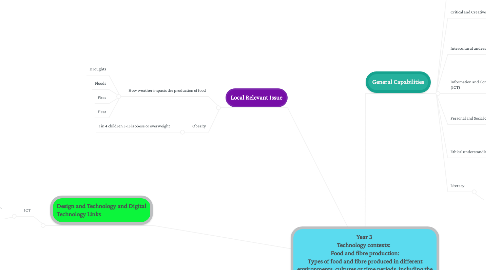
1. Design and Technology and Digital Technology Links
1.1. ICT
1.1.1. Different types of data can be represented in different ways (ACTDIK008)
2. Local Relevant Issue
2.1. How weather impacts the production of food
2.1.1. Droughts
2.1.2. Floods
2.1.3. Fires
2.1.4. Heat
2.2. Obesity
2.2.1. 1 in 4 children 5-15 is obese or overweight
3. Process and Production Skills
3.1. Investigating and defining
3.1.1. Create a sequence of steps to solve a given task (WATPPS16)
3.2. Designing
3.2.1. Develop and communicate ideas using labelled drawings and appropriate technical terms (WATPPS17)
3.3. Producing and implementing
3.3.1. Select, and safely use, appropriate components with given equipment to make a solution (WATPPS18)
3.4. Evaluating
3.4.1. Use criteria to evaluate design processes and solutions developed (WATPPS19)
3.5. Collaborating and managing
3.5.1. Work independently, or collaboratively when required, to plan, safely create and communicate sequenced steps (WATPPS20)
4. General Capabilities
4.1. Numeracy
4.1.1. Students become numerate as they develop the knowledge and skills to use mathematics confidently across other learning areas at school and in their lives more broadly. Recognising and understanding the role of mathematics in the world and having the dispositions and capacities to use mathematical knowledge and skills purposely.
4.2. Critical and Creative thinking
4.2.1. Students develop capability in critical and creative thinking as they learn to generate and evaluate knowledge, clarify concepts and ideas, seek possibilities, consider alternatives and solve problems. Integral to activities that require students to think broadly and deeply using skills, behaviours and dispositions such as reason, logic, resourcefulness, imagination and innovation in all learning areas at school and in their lives beyond school.
4.3. Intercultural understanding
4.3.1. Develop intercultural understanding as they learn to value their own cultures, languages and beliefs, and those of others. They come to understand how personal, group and national identities are shaped, and the variable and changing nature of culture. Learning about and engaging with diverse cultures in ways that recognise commonalities and differences, create connections with others and cultivate mutual respect.
4.4. Information and Communication Technology (ICT)
4.4.1. Develop ICT capability as they learn to use ICT effectively and appropriately to access, create and communicate information and ideas, solve problems and work collaboratively in all learning areas at school, and in their lives beyond school. Learning to make the most of the digital technologies available to them, adapting to new ways of doing things as technologies evolve and limiting the risks to themselves and others in a digital environment.
4.5. Personal and Social capability
4.5.1. Learn to understand themselves and others, and manage their relationships, lives, work and learning more effectively. Range of practices including recognising and regulating emotions, developing empathy for others and understanding relationships, establishing and building positive relationships, making responsible decisions, working effectively in teams, handling challenging situations constructively and developing leadership skills.
4.6. Ethical understanding
4.6.1. As they identify and investigate the nature of ethical concepts, values and character traits, and understand how reasoning can assist ethical judgment. Involves students in building a strong personal and socially oriented ethical outlook that helps them to manage context, conflict and uncertainty, and to develop an awareness of the influence that their values and behaviour have on others.
4.7. Literacy
4.7.1. Students become literate as they develop the knowledge, skills and dispositions to interpret and use language confidently for learning and communicating in and out of school and for participating effectively in society. Listening to, reading, viewing, speaking, writing and creating oral, print, visual and digital texts, and using and modifying language for different purposes in a range of contexts.
5. Integration with other subject ares
5.1. Numeracy
5.1.1. Measure, order and compare objects using familiar metric units of length, mass and capacity (ACMMG061)
5.1.2. Collect data, organise into categories and create displays using lists, tables, picture graphs and simple column graphs, with and without the use of digital technologies (ACMSP069)
5.1.3. Interpret and compare data displays (ACMSP070)
5.2. Humanities and Social Sciences: History
5.2.1. The similarities and differences between places in terms of their type of settlement, the diversity of people (e.g. age, birthplace, language, family composition), the lives of the people who live there, and feelings and perceptions about places (ACHASSK069)
5.3. Health
5.3.1. Actions in daily routines that promote health, safety and wellbeing: healthy eating (ACPPS036)
5.4. Literacy
5.4.1. Listen to and contribute to conversations and discussions to share information and ideas and negotiate in collaborative situations (ACELY1676)
5.4.2. Plan and deliver short presentations, providing some key details in logical sequence (ACELY1677)
5.4.3. Use interaction skills, including active listening behaviours and communicate in a clear, coherent manner using a variety of everyday and learned vocabulary and appropriate tone, pace, pitch and volume (ACELY1792)
